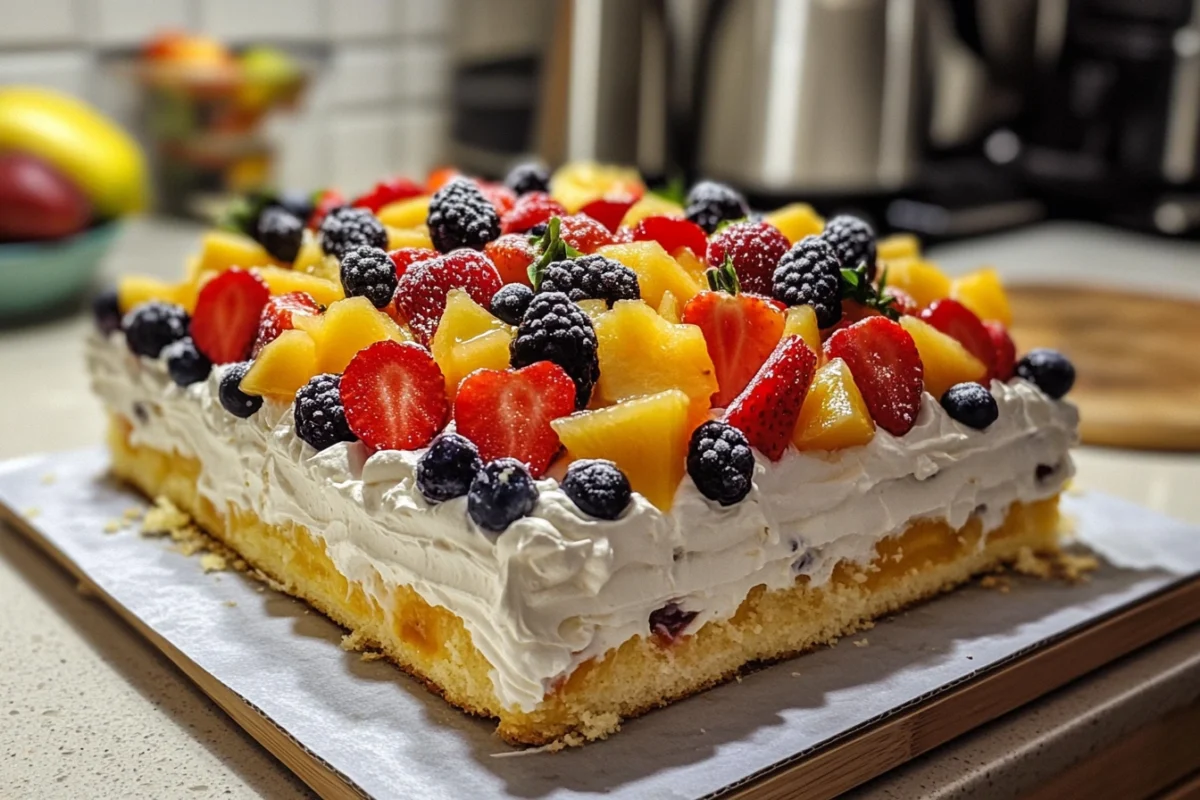Why is my fruit cake soggy? This article explores the common reasons behind a soggy fruitcake, offering tips to avoid this baking mishap. Learn the causes and solutions for a perfect bake.
Why is My Fruit Cake Soggy? Understanding the Problem
A soggy fruit cake can be disappointing. It ruins the texture and taste. Many factors contribute to this issue. Understanding these factors is key. With the right techniques, you can avoid a moist fruit cake disaster. Instead, achieve the ideal, balanced moistness, not sogginess. Let’s explore what causes a fruitcake to become too wet. Therefore, identifying these problems is key to a perfect bake.
. If you’ve added canned fruits, check out Can you add fruit to boxed cake
Too Much Liquid: A Common Culprit
One frequent reason why a fruit cake turns out soggy is using excessive liquid. This can come from too much juice, rum, or other liquids. The fruits themselves can release moisture during baking. If these liquids aren’t balanced, it will be soggy. Therefore, precise measurements are vital. Always follow a recipe carefully. Additionally, be mindful of liquid from the fruits. Consequently, this helps in avoiding excess moisture.
The Role of Fruits and Their Moisture
Fruits, especially those soaked in spirits or syrups, release a lot of liquid when heated. Dried fruits often need rehydration. However, too much soaking can make them too wet. This excess moisture then transfers into the cake batter. As a result, the fruit cake ends up soggy. Therefore, drain fruits thoroughly before adding them. Furthermore, pat them dry with a paper towel to remove any excess liquid. Moreover, remember that different fruits retain different amounts of moisture.
Incorrect Oven Temperature and Baking Time
Another reason why your fruit cake is soggy is incorrect oven settings. Low temperatures and too little baking time prevent the cake from cooking properly. Consequently, the cake remains wet inside. Using a thermometer helps to ensure an accurate oven temp. Furthermore, a cake tester will verify doneness. Adjust baking time as needed, paying close attention. Therefore, proper oven management is critical for success. In addition, always use an accurate oven thermometer.
Baking at the Right Temperature
Baking your fruitcake at the correct temperature is important. Low heat means the cake does not set correctly. It will remain too moist. Use an oven thermometer to check your oven temperature. Furthermore, be aware of oven temperature variations. Check the cake often during baking. In addition, use a cake tester to verify the center is fully baked. Consequently, this will help in ensuring the correct cooking environment. Therefore, never underestimate the importance of oven calibration.
Not Baking Long Enough
Insufficient baking time also leads to a soggy fruit cake. Underbaked cake will have a wet center. It will also lack the correct structure. Always bake until a cake tester comes out clean. Consider baking for a few extra minutes if your cake still appears moist. Therefore, patience is a key ingredient for success. Moreover, using a toothpick or skewer will work as well as a cake tester. Additionally, the center of the cake should feel set to the touch.
The Impact of Fat and Sugar on Soggy Fruit Cake
Fat and sugar also influence the moisture level of your fruit cake. Too much fat or sugar can create a wet environment. This, in turn, leads to a soggy texture. Therefore, balance is key in baking. It is important to follow your recipe carefully. In addition, be aware of how different types of fats and sugars affect the final product. Consequently, this knowledge will help you make better baking decisions.
The Role of Fats in Moisture Retention
Fats like butter and oil contribute to the moistness. However, too much fat can make your fruitcake soggy. The fat keeps the liquid from evaporating. This creates an overly moist and heavy cake. Use the exact amount of fat required by the recipe. This will ensure a balanced texture. Moreover, avoid adding extra fat unless the recipe specifically allows. Therefore, accurate measurements are essential when using fats.
Sugar and Its Contribution to Soggy Texture
Sugar attracts and holds moisture. Too much sugar can result in a wet or soggy fruit cake. Sugar also breaks down to produce liquid when baked. Furthermore, sugar delays the cake from properly setting. Therefore, using the precise amount of sugar stated in your recipe is necessary. In addition, consider the type of sugar. Some sugars attract moisture more than others. Consequently, understanding how sugar behaves will help in avoiding sogginess.
Baking Techniques to Avoid Soggy Fruit Cakes
Baking techniques greatly influence the outcome of your fruitcake. Proper mixing, correct pan selection, and cooling methods are essential. These steps help to ensure that your cake is properly baked and not soggy. Let’s look at how to implement these steps. Therefore, paying attention to technique is crucial for success. In addition, mastering these techniques will improve your baking skills.
Mixing Ingredients Correctly
Overmixing your cake batter can cause a soggy texture. Overmixing develops gluten, making the cake dense and wet. Instead, mix just until the ingredients are combined. A light touch yields a better fruitcake. Therefore, avoid over-mixing for optimal results. Moreover, using a spatula to gently fold the ingredients will help avoid overmixing. Additionally, be aware of how different mixing speeds and times can affect the final result.
Proper Flour Measurement
Too much flour, or not enough, can affect texture. Incorrect flour measurement can contribute to a soggy fruit cake. Consequently, accurately measure your flour for a good result. Use the spoon and level method, instead of scooping the flour. This can make a big difference in the outcome. Furthermore, using a kitchen scale to measure dry ingredients will give you accurate results. Moreover, understand that different types of flour absorb moisture differently.
Choosing the Right Baking Pan
The correct baking pan also impacts the final result. Use the size recommended in the recipe. Too small a pan results in a dense, undercooked center. Too large of a pan may lead to the cake being overcooked. Also consider material. Dark pans bake faster than light pans. Therefore, use the correct size and material for best baking results. In addition, a deeper pan may require longer baking time. Consequently, understanding how pan size affects baking is essential.
Cooling Your Fruit Cake Properly
Cooling your fruit cake properly is crucial. Do not try to remove the cake from the pan too soon. It needs time to set. Let the cake cool completely in the pan before removing it. In addition, consider placing it on a wire rack to allow air circulation for more uniform cooling. Therefore, be patient during this crucial stage. Moreover, cooling rack placement ensures air circulation under the cake. Additionally, the cooling time is essential for the cake structure to stabilize.
Storing for the Best Results
After baking and cooling, how you store your fruitcake matters. Wrap the cake tightly. This will help prevent excess moisture from making it soggy. Store it in a cool, dry place. This way, the texture of the cake will be perfect when you are ready to eat it. This proper storage ensures a satisfying eating experience. Furthermore, consider using an airtight container for storing. Additionally, a cool place helps in slowing down moisture absorption.
Common Mistakes That Lead to Soggy Fruit Cake
Several common mistakes can lead to a soggy fruit cake. Identifying these pitfalls is key. This will help you bake a perfect fruitcake every time. Let’s examine some common errors. Therefore, being mindful of these common mistakes can prevent a soggy fruit cake. Furthermore, learning from these common baking pitfalls is a key aspect of improvement.
Overcrowding the Pan
Overfilling the baking pan can cause a soggy fruit cake. When the pan is too full, the center will not cook evenly. This results in a wet center. It is better to use the correct pan size for even baking. Alternatively, divide the batter into multiple pans to ensure even cooking. Therefore, never overfill the baking pan. Additionally, always leave some room for the cake to rise while baking. Consequently, an overcrowded pan will prevent even heat distribution.
Incorrect Ingredient Substitutions
Substituting ingredients may lead to unpredictable results. Avoid changing the recipe unless you know the baking science. This will result in a different outcome. Too much liquid from different ingredients can cause sogginess. Therefore, use the specific ingredients called for in the recipe. Furthermore, substitutions can alter the chemical reactions in baking. Moreover, always research substitutions carefully if you must make them. Consequently, ingredient awareness is essential for predictable baking results.
Not Preheating the Oven Properly
A cold oven affects the baking process. Consequently, preheat your oven for the suggested time. This will provide an even heat environment. It will also prevent the cake from becoming soggy. Therefore, always wait until the oven is at the required temperature. In addition, using an oven thermometer will make sure you are at the correct temperature. Furthermore, this ensures that the cake bakes properly from the start. Consequently, preheating the oven is a fundamental part of successful baking.
Techniques for Saving a Soggy Fruit Cake
Sometimes, despite your best efforts, a fruit cake still ends up soggy. Fortunately, there are ways to try and rescue it. These steps can help improve the cake’s texture. Let’s look at ways you can avoid wasting your time and effort. Therefore, while rescuing a soggy cake is possible, it’s better to prevent it. Furthermore, remember that prevention is always more effective than a cure.
Returning the Cake to the Oven
If your cake is too wet when tested, you can try putting it back in the oven. Increase the cooking time for about 10-15 minutes. The heat may help to dry it out further. This step is good for underbaked cakes. Keep an eye on it to make sure it does not burn. Use a cake tester to verify it’s done. Moreover, using a slightly lower oven temperature may be better. Additionally, monitor the cake closely during the extended baking time. Consequently, this can salvage underbaked or soggy cake.
Drying Out the Cake Slice
For an individual soggy slice, try this trick. Put it on a baking sheet. Bake at a low temperature. The heat will dry it out. Make sure to watch it, so it does not overcook. This method is a good option for small amounts. However, it may not work on large amounts. It is always better to try and bake the cake perfectly. Furthermore, this method will help with texture and removing any excess moisture. Moreover, this is best for slightly soggy slices that can be dried out further.
Using a Broiler for Crispiness
If you like a crispy top, you can use a broiler. Place the cake under the broiler for a minute. It will help to give the cake a crisper top. However, be very careful not to burn it. It works if the cake is already mostly cooked and only slightly soggy. Therefore, this will only work for specific situations. Additionally, use a lower broiler setting to avoid burning. Moreover, keep an eye on the cake constantly, to ensure even crisping. Consequently, a broiler can fix minor sogginess issues.
How to Prevent a Soggy Fruit Cake in the Future
Preventing a soggy fruit cake involves careful planning. Moreover, precision in baking is essential. Therefore, let’s summarize the key takeaways. This will help you bake the perfect cake each time. In addition, consistent practice and following these guidelines will lead to better baking results.
Following Recipes Accurately
Always adhere to the recipe instructions closely. Do not make changes unless you fully understand what the impact will be. Too much liquid or different ingredients can result in a wet cake. Therefore, precise measurements are essential. Thus, accuracy is crucial. Furthermore, read through the whole recipe before you start baking. Moreover, use measuring tools to be precise with each ingredient. Consequently, this will reduce error when baking.
Using Quality Ingredients
Use good-quality fresh ingredients for the best results. Old or stale ingredients may affect the cake’s texture. Consequently, use quality fats and fresh fruit for better results. In addition, use fresh spices to enhance the flavor and aroma. Therefore, the result will be much better. Furthermore, always use fresh baking powder and baking soda. Moreover, pay attention to the condition of your ingredients. Consequently, using fresh and high-quality items will enhance your final bake.
Keeping a Baking Journal
Keeping a baking log can be very useful. Note down any adjustments or changes. This will help you learn from any mistakes. Also, noting down successes will allow you to repeat the recipe correctly. This step can greatly improve your baking experience. It also helps you perfect recipes. Furthermore, keeping a baking journal will provide a great resource to learn from. Moreover, you can track different baking times and temperatures for your oven. Consequently, this data will help you improve each time.
Practice Makes Perfect
Baking, like any other skill, improves with experience. Practice allows you to get a better feel for the dough. This in turn helps improve your baking skills. The more you bake, the better you will become. Therefore, enjoy the baking process. In addition, do not be afraid to try new things and experiment. Furthermore, baking more frequently will give you better baking intuition. Consequently, it is through practice that your skills will improve.
Conclusion
In conclusion, achieving a perfectly baked fruit cake that is moist but not soggy requires a combination of precision, patience, and understanding the baking process. Several factors such as too much liquid, incorrect oven temperatures, improper mixing, and wrong pan usage can contribute to a soggy fruit cake. By paying attention to these critical areas, following recipes closely, and making small adjustments to each bake, you can improve your skills and prevent your fruit cake from becoming soggy. Remember that baking is a skill that improves with practice. Therefore, each bake will bring you one step closer to the perfect fruit cake.
Frequently Asked Questions (FAQs)
Why is my fruit cake so moist?
A fruit cake is too moist when it has too much liquid. This can be from overly wet fruits, or too much liquid in the recipe. Also, underbaking can lead to a very moist outcome. Using the correct amounts of ingredients and baking techniques is therefore important. Furthermore, always remember the importance of draining and patting down wet fruits. Moreover, accurate measurement is important to avoid too much liquid.
Can you over soak fruit for fruit cake?
Yes, over-soaking fruit for a fruit cake is a common mistake. Too much soaking results in the fruit releasing too much liquid during baking. Consequently, the cake will be soggy. It is important to drain the fruits properly after soaking them. Therefore, moderation is key. Moreover, use a paper towel to remove excess liquid. Additionally, pay attention to the soaking time.
How can I tell if a fruit cake is cooked?
The best way to tell if a fruit cake is cooked is by using a cake tester. Insert it into the center of the cake. If it comes out clean, the cake is done. Additionally, the top of the cake should be golden brown. The sides should pull away slightly from the pan. Therefore, these signs will help you know the cake is done. Furthermore, the cake should feel firm to the touch. Moreover, be aware that dark pans may bake differently.
Why is the center of my fruit cake still wet?
A wet center in a fruit cake usually means it is underbaked. It can also be due to too much moisture in the batter or overcrowding the pan. Make sure your oven is at the right temperature. Also, bake the cake for the correct time. Using a cake tester will help you ensure it is done. Additionally, the cake should feel set to the touch. Furthermore, remember to let the cake cool in the pan for some time.
For other temperature-related challenges, explore Why is my baked ziti so dry? to



